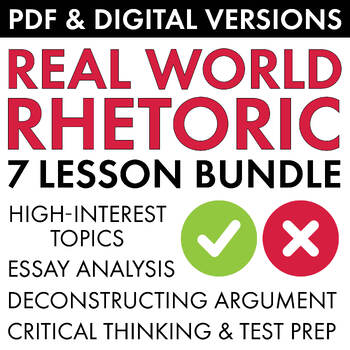Real-World Rhetoric Bundle Argument Analysis of Modern Essays, Critical Thinking
- Zip
- Google Apps™

What educators are saying
Description
What does it take to win an argument? With this bundle of seven real-world rhetorical analysis lessons, students will examine short articles on high-interest topics, identify specific rhetorical tools including ethos, pathos, and logos, and determine whether each writer is ultimately effective in swaying the reader.
Each of these real-world rhetoric lessons include:
• A full-text copy of a public domain argument essay
• A paper-saving handout of short-answer questions
• A Google Drive version of the essay and question set for students to complete online
• A detailed answer key to make grading easier and help the teacher lead a discussion of the answers
These materials were designed to help students begin the process of preparation for the analysis of argument prompts featured in the AP English Language and Composition exam and the GED Reasoning Through Language Arts essay. They also work great as stand-alone lessons, supplements, or emergency sub plans for any high school English class.
These lessons, built for students in grades 9-12, take between 40-45 minutes to complete or a bit longer if you review answers/allow students to debate some of the questions.
This bundle includes seven products, all sold separately at my store. If you’d like to take a closer look at any of the specific lesson materials, please click on the links below. Regularly, each lesson is $2.50 (or $17.50 for all seven); in this bundle, you’ll save 20% by purchasing them altogether for just $13.99.
Want to take a closer look at the individual lesson materials?
• Click here for Real-World Rhetoric #1 – Should we kill spiders we find in our homes?
• Click here for Real-World Rhetoric #2 – Should parents post their children’s bad behavior on social media?
• Click here for Real-World Rhetoric #3 – Should a lottery determine college admissions?
• Click here for Real-World Rhetoric #4 – Should the U.S. stop following Daylight Saving Time?
• Click here for Real-World Rhetoric #5 – Should students earn cash for good grades?
• Click here for Real-World Rhetoric #6 – Should doctors use intestinal worms in treatment plans?
• Click here for Real-World Rhetoric #7 – Should women deliver their babies at home or in hospitals?
Cover art/icons licensed via CanvaPro.





